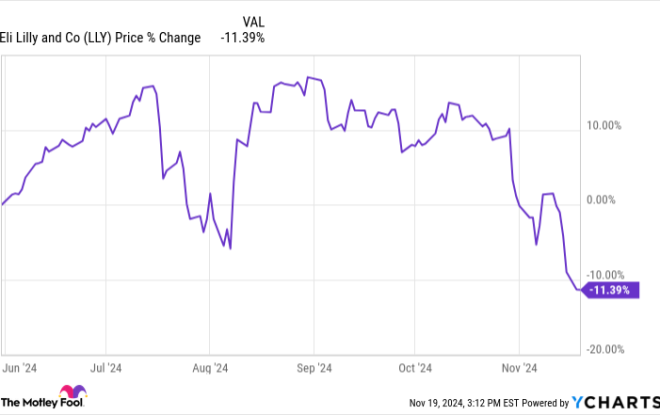Wall Street's Most Anticipated Stock Split of the 4th Quarter May Be Announced This Week
For much of the last two years, Wall Street and investors have been fixated on the artificial intelligence (AI) revolution. But what they might not realize is how important stock-split euphoria has been for pushing Wall Street’s major indexes higher in 2024.
A stock split is a tool public companies have at their disposal that allows them to superficially adjust their share price and outstanding share count by the same factor. Splits are surface-scratching in the sense that they don’t alter a company’s market cap or in any way affect its underlying operating performance.
Splits come in two varieties, one of which is undeniably favored by investors. Reverse-stock splits aim to increase a company’s share price, often with the purpose of maintaining minimum listing standards for a major stock exchange. Since this is the type of split conducted by struggling businesses, it’s one that investors usually avoid.
On the other hand, forward-stock splits get investors excited. A forward split reduces a company’s share price to make it more nominally affordable for everyday investors who lack access to fractional-share purchases through their broker. This type of split is almost always conducted by companies with a rich history of outperforming their peers.
A little over a dozen high-profile stock splits have been announced or completed in 2024, all but one of which is a forward split.
Wall Street has flocked to AI stock-split stocks
With AI stocks in the spotlight, it’s no surprise to find that three of Wall Street’s most-prominent splits of the year are attached to this highly touted trend:
-
Nvidia (NASDAQ: NVDA) completed a historic 10-for-1 forward split in June.
-
Broadcom (NASDAQ: AVGO) closed a 10-for-1 split (its first ever) in mid-July.
-
Super Micro Computer (NASDAQ: SMCI) will effect a 10-for-1 split after the close of trading on Sept. 30.
Nvidia has been the flagship of the rise of AI and is, arguably, the most-decorated of all stock-split stocks in 2024. Shares of the company have catapulted higher by more than 675% since the start of 2023 due to the dominance of its graphics processing units (GPUs) in AI-accelerated data centers — an estimated 98% share of GPUs shipped to data centers in 2022 and 2023, according to TechInsights. Demand for its H100 GPU is backlogged, leading to exceptional pricing power and a sizable uptick in the company’s gross margin.
Broadcom has quickly slid in as the preferred choice in networking solutions for high-compute data centers. Its solutions are responsible for reducing tail latency and maximizing the computing capacity of GPUs in enterprise data centers training large language models, running generative AI solutions, and making split-second decisions. Although Broadcom is much more than an AI stock, AI is the source of excitement surrounding the company right now.
As for Super Micro Computer, it’s become one of the leading infrastructure providers of the AI revolution. Super Micro’s customizable rack servers, which incorporate Nvidia’s H100 GPUs, are in high demand — net sales for the company jumped 110% last year — as businesses look to establish first-mover advantages.
But while AI stocks have been the bee’s knees on Wall Street throughout much of 2024, another brand-name company is perfectly positioned to announce a stock split and steal the spotlight in the fourth quarter.
This may be the most-anticipated stock split of the fourth quarter
The stock in question that could set Wall Street abuzz if it announces a forward split later this week is none other than warehouse club Costco Wholesale (NASDAQ: COST).
Costco is set to report its fiscal fourth-quarter operating results after the closing bell on Sept. 26, which would be the perfect time to also announce a stock split.
As of the closing bell on Sept. 18, a single share of Costco was tipping the scales at north of $892. More importantly, the company has conducted only three splits since going public, the last of which occurred all the way back in January 2000. In other words, it looks to be long overdue to make shares more affordable for retail investors and its employees who want to participate in the company’s employee stock purchase plan.
The only logical reason Costco has likely avoided a split for so long — aside from a greater prevalence of fractional-share purchase capabilities through most online brokers — is the fact that roughly 72% of its shares are held by institutional investors that aren’t concerned about a high nominal share price. But at some point, a near-$900 share price becomes burdensome to its employees and/or everyday investors. I believe we’ve reached that point with Costco.
Furthermore, Costco’s valuation is historically rich. It’s currently trading at a multiple of 50 (yes, 50!) times forward-year earnings per share, which is pretty much unheard of for a retailer. The company is going to need some serious buzz if it’s to grow into its current valuation, and the first stock split in 24 years might just be what the doctor ordered.
Unmasking Costco’s recipe for success
While the stage is undeniably set for Costco Wholesale to wow Wall Street with a stock split, the company’s underlying operations continue to fire on all cylinders.
Costco’s recipe for success begins with the advantage it possesses from its sheer size. Being able to purchase products in bulk helps to lower the per-unit cost of each item. Ultimately, this allows the company to undercut local shops and national grocery chains on price and provide a value proposition to consumers that keeps them coming back.
Costco is also a consumer staples stock. This is to say that it sells a variety of basic need goods that consumers are going to buy regardless of how well or poorly the U.S. economy is performing, such as food, beverages, and household cleaning/sanitary products. It has a lure to drive traffic into its stores in any economic climate.
Another key ingredient to Costco’s success story is its membership-based operating model. The $65 and $130 annual fees Costco collects from its members is high margin and flows straight to its bottom line. These fees provide an even firmer margin buffer that allows the company to undercut its peers on price to drive membership growth.
Last but not least, paying for an annual membership tends to incent loyalty in shoppers. Consumers will want to get the most out of their membership and are, therefore, more likely to head to Costco for their big-dollar purchases. Getting consumers into its stores is half the battle — and it’s one that Costco has been winning for decades.
Should you invest $1,000 in Costco Wholesale right now?
Before you buy stock in Costco Wholesale, consider this:
The Motley Fool Stock Advisor analyst team just identified what they believe are the 10 best stocks for investors to buy now… and Costco Wholesale wasn’t one of them. The 10 stocks that made the cut could produce monster returns in the coming years.
Consider when Nvidia made this list on April 15, 2005… if you invested $1,000 at the time of our recommendation, you’d have $710,860!*
Stock Advisor provides investors with an easy-to-follow blueprint for success, including guidance on building a portfolio, regular updates from analysts, and two new stock picks each month. The Stock Advisor service has more than quadrupled the return of S&P 500 since 2002*.
*Stock Advisor returns as of September 16, 2024
Sean Williams has no position in any of the stocks mentioned. The Motley Fool has positions in and recommends Costco Wholesale and Nvidia. The Motley Fool recommends Broadcom. The Motley Fool has a disclosure policy.
Wall Street’s Most Anticipated Stock Split of the 4th Quarter May Be Announced This Week was originally published by The Motley Fool





Leave a Reply